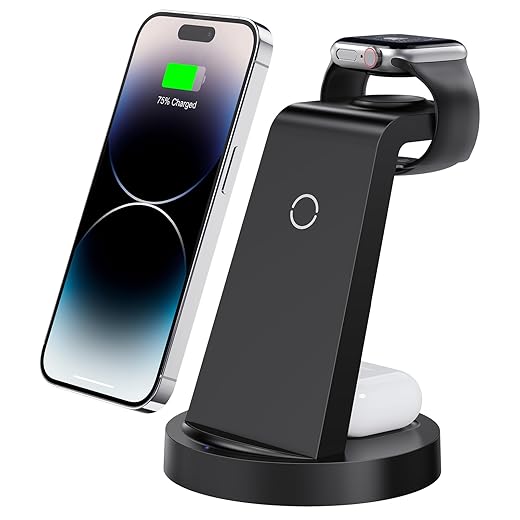







Evaluating the Reliability of Wireless Charging Across Different iPhone Models
Wireless charging has revolutionized the way we power our devices, providing a convenient solution to the age-old problem of tangled cords and frayed cables. For iPhone users, this technology offers a seamless experience, but how reliable is it across various models? Let’s dive into the nuances of wireless charging, exploring its reliability in different iPhone iterations, and uncovering what you need to know to make the most of this modern convenience.
Understanding Wireless Charging Technology
Before we evaluate reliability, it’s crucial to understand how wireless charging works. At its core, wireless charging utilizes electromagnetic fields to transfer energy between two objects—typically a charging pad and a smartphone. This process, known as inductive charging, allows you to simply place your iPhone on a compatible pad to recharge it without plugging in a cable.
But does this convenience come at a cost? And how does it stack up against traditional wired charging methods? Let’s explore.
The Evolution of iPhones and Wireless Charging
Apple introduced wireless charging with the iPhone 8, iPhone 8 Plus, and iPhone X. As newer models emerged, the technology continued to evolve. iPhones now support not only standard Qi wireless charging but also features like MagSafe, which enhances the charging experience through magnetic alignment.
Each model has its quirks and capabilities. For instance, while the iPhone 8 and iPhone X can handle standard Qi chargers, newer models like the iPhone 12 and later integrate MagSafe technology, allowing for faster and more efficient charging. The question remains: does this mean that every iPhone model can be relied upon for a consistent charging experience?
Performance Across Different iPhone Models
1. **iPhone 8 and iPhone X**: These pioneering models introduced wireless charging to the iPhone lineup. Users often report decent charging speeds, although they may vary based on the quality of the charging pad. Some users experience slower charging during intensive tasks, such as gaming or streaming.
2. **iPhone XR and iPhone 11**: With these models, Apple improved the wireless charging experience. Users noted better heat management, which is crucial for maintaining battery health. However, charging times can still be affected by external factors like case thickness and ambient temperature.
3. **iPhone 12 and iPhone 13**: Here, we enter the realm of MagSafe. The magnetic alignment ensures that your iPhone is always positioned optimally for charging, which can significantly enhance efficiency. Users enjoy faster charging speeds, while the magnetic feature adds an extra layer of convenience.
4. **iPhone 14 and Beyond**: While still new, early reports indicate that these models continue to refine the wireless charging experience. The integration of MagSafe has become standard, promising faster and more reliable charging, although real-world usage will dictate the ultimate reliability over time.
Factors Influencing Wireless Charging Reliability
While the progression of technology has improved reliability, several factors can influence performance:
– **Charger Quality**: Not all wireless chargers are created equal. Investing in a reputable brand can make a significant difference in charging speed and reliability.
– **Phone Case**: A bulky or thick phone case can hinder the charging process. If you’re struggling with wireless charging, consider removing your case to see if that enhances the experience.
– **Alignment**: Especially with non-MagSafe chargers, proper alignment can be a game-changer. A misaligned phone may not charge efficiently, leading to frustration.
– **Environment**: Temperature plays a role in charging efficiency. Extreme heat can slow charging, while cold conditions may cause the device to charge more slowly or not at all.
Is Wireless Charging Worth It?
You might be wondering whether the convenience of wireless charging is worth the potential downsides. Imagine having to fumble with cords every time you want to power up your device. Wireless charging eliminates that hassle, making it an attractive option for many users.
However, if speed and efficiency are your priorities—especially for heavy users—wired charging might still hold the edge. In contrast, if you value convenience and are willing to invest in quality equipment, wireless charging can be a game-changer.
Conclusion
Wireless charging has come a long way since its inception in the iPhone lineup. While reliability varies across models and is influenced by numerous factors, the convenience it offers is undeniable. By understanding how your specific iPhone model interacts with wireless charging technology, you can enhance your experience and enjoy a cable-free lifestyle.
In the end, whether you prefer the simplicity of wireless charging or the traditional wired method, the choice ultimately boils down to your personal needs and preferences.
FAQs
1. Can I use any wireless charger with my iPhone?
Yes, as long as the charger is Qi-compatible, it should work with your iPhone. However, for the best performance, especially with newer models, consider using a MagSafe charger.
2. Does wireless charging affect battery health?
Generally, wireless charging does not harm battery health if used properly. However, overheating can be a concern, so ensure your device has proper ventilation while charging.
3. Why is my iPhone charging slowly on a wireless charger?
Slow charging can be attributed to several factors, including the quality of the charger, phone case thickness, or misalignment on the charging pad. Ensure that your charger is compatible and functioning properly.
